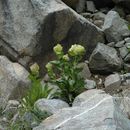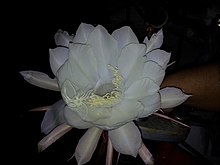pt-BR
nomes no trilho de navegação


Saussurea obvallata ye una especie de la familia de les asteracees. Ye orixinaria de Himalaya y Uttar Pradesh, n' India, Norte de Myanmar y sudoeste de China. N'Himalaya, atopar a una altitú de 4500 metros. Considérase la flor del estáu d'Uttaranchal y Uttar Pradesh.
Saussurea obvallata ye una planta perenne que crez hasta los 0,3 m d'altor. Les flores son hermafrodites (tienen dambos órganos, masculinos y femeninos) y son polinizaes por inseutos.
Nos dibuxos hindús de Brahma, vese sentáu sobre una flor de color rosa que s'asemeya a la flor de lotu ( en sánscritu : Kamal), que ye la flor nacional d'India. Polo tanto la xente diz que la flor rosa de Nelumbo nucifera ye la flor de Brahma kamal. Sicasí, hai persones qu'afirmen que la flor ye Epiphyllum oxypetalum, que floria de nueche. Dellos indios del Norte afirmen que la flor ye de Saussurea obvallata.
La planta ye considerada una yerba na medicina tibetana. El so nome ye ཤཟའ བདྭད མཤ དཤྭ (Sah-du-Goh ghoo). Tien un sabor amargoso. Tola planta utilízase. Ta en peligru porque la xente talo cortando pal so propiu usu. Tamién s'utiliza pa curar los trestornos urogenitales.[1]
Saussurea obvallata describióse por (DC.) Edgew. y espublizóse en Linnaea 19: 331. 1846.[2]
Saussurea: nome xenéricu que foi nomáu por De Candolle n'honor de Nicolas-Théodore de Saussure (1767-1845).
obvallata: epítetu llatín ;Sinonimia:
 Esta páxina forma parte del wikiproyeutu Botánica, un esfuerciu collaborativu col fin d'ameyorar y organizar tolos conteníos rellacionaos con esti tema. Visita la páxina d'alderique del proyeutu pa collaborar y facer entrugues o suxerencies.
Esta páxina forma parte del wikiproyeutu Botánica, un esfuerciu collaborativu col fin d'ameyorar y organizar tolos conteníos rellacionaos con esti tema. Visita la páxina d'alderique del proyeutu pa collaborar y facer entrugues o suxerencies. Saussurea obvallata ye una especie de la familia de les asteracees. Ye orixinaria de Himalaya y Uttar Pradesh, n' India, Norte de Myanmar y sudoeste de China. N'Himalaya, atopar a una altitú de 4500 metros. Considérase la flor del estáu d'Uttaranchal y Uttar Pradesh.
ब्रह्म कमल (वानस्पतिक नाम : Saussurea obvallata) एस्टेरेसी कुल का पौधा है। सूर्यमुखी, गेंदा, डहलिया, कुसुम एवं भृंगराज इस कुल के अन्य प्रमुख पौधे हैं।
भारत में Epiphyllum oxypetalum को भी 'ब्रह्म कमल' कहते हैं।
यह हिमालय की वादियों में खिलता है। फिलहाल इसकी 1 तस्वीर भारत तिब्बत सीमा पुलिस ने जारी की है। यह 14 साल में खिलता है। यह सिर्फ रात में खुलता है और सुबह होते ही इसका फूल बंद हो जाता है।
Monika khokhar
ब्रह्म कमल (वानस्पतिक नाम : Saussurea obvallata) एस्टेरेसी कुल का पौधा है। सूर्यमुखी, गेंदा, डहलिया, कुसुम एवं भृंगराज इस कुल के अन्य प्रमुख पौधे हैं।
भारत में Epiphyllum oxypetalum को भी 'ब्रह्म कमल' कहते हैं।
బ్రహ్మ కమలము (శాస్త్రీయ నామం: Saussurea obvallata) అనేది Asteraceae (Sunflower family) కి చెందిన మొక్క. ఇది హిమాలయ పర్వతాలు, మరియూ ఉత్తర ప్రదేశ్, ఉత్తర బర్మా, టిబెట్, నేపాల్, దక్షిణ చైనా దేశాలలో కనబడుతుంది. బ్రహ్మకమలం ఉత్తరాఖండ్ రాష్ట్రీయ పుష్పము. ఈ మొక్కను King of Himalayan flower అని అంటారు. ఈ మొక్క పై ఆకులే పువ్వుగా రూపాంతరం చెందుతాయి.
హిందూ పురాణాల ప్రకారం బ్రహ్మకమలం పై బ్రహ్మదేవుడు కూర్చుని ఉంటాడు. ఆయుర్వేదం ప్రకారం ఈ మొక్కను కాలు-చేతి వ్రేళ్ళ పక్షవాతానికి, మరియూ మెదడు సంబంధిత వ్యాధులకు వాడతారు. ఉత్తరాంచల్ రాష్ట్రంలో బ్రహ్మకమలం ఆకులు, వేళ్ళు ఎండబెట్టి పొడిగా చేసి, 200 గ్రాముల పొడిని దేవదారు 20 మి.లీ నూనెలో కలిపి గుజ్జుగా చేసి విరిగిన ఎముకల భాగాల మీద పూస్తారు [1]. మధ్య హిమాలయాల్లో భోటియా తెగవారు తలనొప్పి, మానసిక సమస్యలకు బ్రహ్మకమల విత్తనాల నుండి తీసిన నూనెను తలకు వ్రాసుకుంటారు. మూత్ర సంబంధిత సమస్యలకు బ్రహ్మకమల పువ్వులను మిస్రితో కలిపి వండి సేవిస్తారు [2].
బ్రహ్మకమలం గురించి అస్పష్టత ఉంది. ఉత్తర భారతదేశంలో పైన చెప్పిన మొక్కను బ్రహ్మకమలంగా భావిస్తారు. దక్షిణ భారతదేశంలో రాత్రి సమయాల్లో పువ్వులు వికసించే ఎఫీఫైలమ్ ఆక్సిపెటాలమ్ (Epiphyllum Oxypetalum) అను కాక్టస్ మొక్కను బ్రహ్మకమలంగా భావిస్తారు. మరికొద్ది మంది మాత్రం కమలము (లేదా తామర - Nelumbium Nucifera) ను బ్రహ్మ కమలంగా భావిస్తారు.
బ్రహ్మ కమలము (శాస్త్రీయ నామం: Saussurea obvallata) అనేది Asteraceae (Sunflower family) కి చెందిన మొక్క. ఇది హిమాలయ పర్వతాలు, మరియూ ఉత్తర ప్రదేశ్, ఉత్తర బర్మా, టిబెట్, నేపాల్, దక్షిణ చైనా దేశాలలో కనబడుతుంది. బ్రహ్మకమలం ఉత్తరాఖండ్ రాష్ట్రీయ పుష్పము. ఈ మొక్కను King of Himalayan flower అని అంటారు. ఈ మొక్క పై ఆకులే పువ్వుగా రూపాంతరం చెందుతాయి.
ಸೋಸೂರಿಯಾ ಆಬ್ವ್ಯಾಲೇಟಾ (ಬ್ರಹ್ಮಕಮಲ) ಹಿಮಾಲಯ, ಉತ್ತರಾಖಂಡ, ಉತ್ತರ ಬರ್ಮಾ ಮತ್ತು ನೈಋತ್ಯ ಚೀನಾಕ್ಕೆ ಸ್ಥಳೀಯವಾದ ಹೂಬಿಡುವ ಸಸ್ಯದ ಒಂದು ಜೀವಜಾತಿ. ಹಿಮಾಲಯದಲ್ಲಿ, ಅದು ಸುಮಾರು ೪೫೦೦ ಮಿ. ಎತ್ತರದಲ್ಲಿ ಕಾಣಿಸುತ್ತದೆ. ಅದು ಉತ್ತರಾಖಂಡದ ರಾಜ್ಯಹೂವು.ಅದು ರಾತ್ರಿ ಅರಳಿ ಬೆಳಗಾಗುವಷ್ಟರಲ್ಲಿ ಬಾಡಿ ಹೋಗುತ್ತದೆಂದು ಹೇಳಲಾಗುತ್ತದೆ.

ಸೋಸೂರಿಯಾ ಆಬ್ವ್ಯಾಲೇಟಾ (ಬ್ರಹ್ಮಕಮಲ) ಹಿಮಾಲಯ, ಉತ್ತರಾಖಂಡ, ಉತ್ತರ ಬರ್ಮಾ ಮತ್ತು ನೈಋತ್ಯ ಚೀನಾಕ್ಕೆ ಸ್ಥಳೀಯವಾದ ಹೂಬಿಡುವ ಸಸ್ಯದ ಒಂದು ಜೀವಜಾತಿ. ಹಿಮಾಲಯದಲ್ಲಿ, ಅದು ಸುಮಾರು ೪೫೦೦ ಮಿ. ಎತ್ತರದಲ್ಲಿ ಕಾಣಿಸುತ್ತದೆ. ಅದು ಉತ್ತರಾಖಂಡದ ರಾಜ್ಯಹೂವು.ಅದು ರಾತ್ರಿ ಅರಳಿ ಬೆಳಗಾಗುವಷ್ಟರಲ್ಲಿ ಬಾಡಿ ಹೋಗುತ್ತದೆಂದು ಹೇಳಲಾಗುತ್ತದೆ.
"Saussurea obvallata (DC.) Edgew". The Plant List. Retrieved 6 August 2013.
Saussurea obvallata is a species of flowering plant in the Asteraceae. It is native to the Alpine meadows of the Himalayas, in India, Bhutan, Nepal, Pakistan and southwest China at altitudes of 3,700 to 4,600 m.[2]
Saussurea obvallata is a perennial growing to 0.3 m (1 ft). The flowers are hermaphrodite (have both male and female organs) and are pollinated by insects. Flowers bloom in mid-monsoon (July–August) amongst the rocks and grasses of the hillside at an altitudinal range of 3700–4600 m. Flower heads are purple, hidden from view in layers of yellowish-green papery bracts, which provide protection from the cold mountain environment. The flowers can be seen from July through September, after which the above-ground portions of the plant die back, becoming visible again in April.[3][4]
The Saussurea genus are named for alpine scientist Horace Bénédict de Saussure, while the specific epithet obvallata is derived from obvallatus, meaning "surrounded by wall;" in this case the flower's involucriform bracts.[4]
A postal stamp featuring the image of the flower and labeled Sassurea obvallata in English and Brahma Kamal in the Devanagari script was issued by the Indian government in 1982. Sometime after the new state of Uttarakhand was created in 2007 (changing its name from Uttaranchal, created in 2000), the flower was declared the state flower.[5] The flowers are used as offering in the hill temples, like the shrines of Badrinath. The thick curved root of the plant is applied to bruises and cuts, as part of local medicine.[6]
{{cite journal}}: Cite journal requires |journal= (help) Saussurea obvallata is a species of flowering plant in the Asteraceae. It is native to the Alpine meadows of the Himalayas, in India, Bhutan, Nepal, Pakistan and southwest China at altitudes of 3,700 to 4,600 m.
Saussurea obvallata es una especie de la familia de las compuestas. Es originaria del Himalaya, Uttar Pradesh en India, norte de Birmania y sudoeste de China. En el Himalaya, alcanza una altitud de 4500 metros. Se considera la flor de los estados de Uttarakhand y Uttar Pradesh.
Saussurea obvallata es una planta perenne que crece hasta los 0,3 m de altura. Las flores son hermafroditas (tienen ambos órganos, masculinos y femeninos) y son polinizadas por insectos.
En los dibujos hindúes de Brahma, se ve sentado sobre una flor de color rosa que se asemeja a la flor de loto (en sánscrito, कमल), que es la flor nacional de India. Por lo tanto la gente dice que la flor rosa de Nelumbo nucifera es la flor de Brahma kamal. Sin embargo, hay personas que afirman que la flor es Epiphyllum oxypetalum, que florece de noche. Algunos indios del Norte afirman que la flor es de Saussurea obvallata.
La planta es considerada una hierba en la medicina tibetana. Su nombre es ཤཟའ བདྭད མཤ དཤྭ (Sah-du-Goh ghoo). Tiene un sabor amargo. Toda la planta se utiliza. Está en peligro porque la gente la está cortando para su propio uso. También se utiliza para curar los trastornos urogenitales.[1]
Saussurea obvallata fue descrita por (DC.) Edgew. y publicado en Linnaea 19: 331. 1846.[2]
Saussurea: nombre genérico que fue nombrado por De Candolle en honor de Nicolas-Théodore de Saussure (1767-1845).
Saussurea obvallata es una especie de la familia de las compuestas. Es originaria del Himalaya, Uttar Pradesh en India, norte de Birmania y sudoeste de China. En el Himalaya, alcanza una altitud de 4500 metros. Se considera la flor de los estados de Uttarakhand y Uttar Pradesh.
Saussurea obvallata là một loài thực vật có hoa trong họ Cúc. Loài này được (DC.) Edgew. miêu tả khoa học đầu tiên năm 1846.[1]
Saussurea obvallata là một loài thực vật có hoa trong họ Cúc. Loài này được (DC.) Edgew. miêu tả khoa học đầu tiên năm 1846.
苞叶雪莲(学名:Saussurea obvallata)是菊科风毛菊属的植物。分布在印度、锡金、尼泊尔、克什米尔以及中国大陆的云南、甘肃、四川、西藏、青海等地,生长于海拔3,200米至4,700米的地区,常生于山坡多石处、高山草地、溪边石隙处及流石滩,目前尚未由人工引种栽培。
苞叶风毛菊(中国高等植物图鉴)
苞叶雪莲(学名:Saussurea obvallata)是菊科风毛菊属的植物。分布在印度、锡金、尼泊尔、克什米尔以及中国大陆的云南、甘肃、四川、西藏、青海等地,生长于海拔3,200米至4,700米的地区,常生于山坡多石处、高山草地、溪边石隙处及流石滩,目前尚未由人工引种栽培。